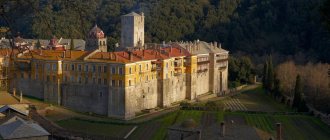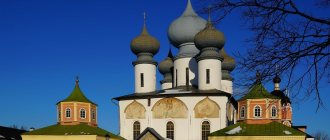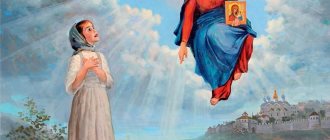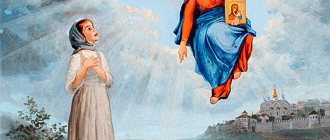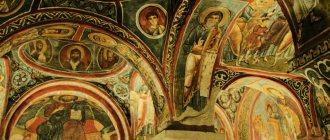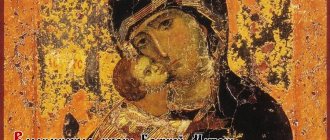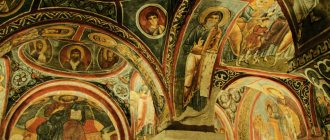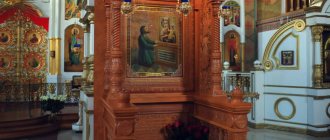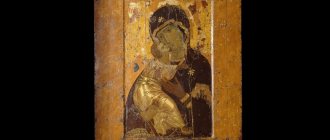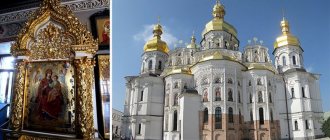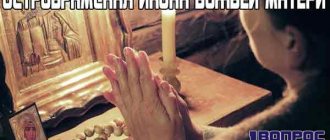Thanks to historical sources, it is now known that in the tenth century, an icon of the Mother of God appeared on the territory of the Iversky Monastery, which is considered to be miraculous. It became of great importance on the territory of the monastic monastery. It is considered to be a talisman of a holy place and a real treasure. Therefore, she is considered an intercessor and protector from enemies and adversaries. Also, the Iveron Icon of the Mother of God is considered capable of helping in all endeavors and aspirations.
Celebration days:
- 25 February
- April 26—transitionable
- the 6th of May
- October 26
The history of acquiring the image
According to canonical sources, this icon was painted by the Evangelist Luke at the dawn of Christianity. However, most likely, we are talking about the primary image of the Hodegetria (“Guide”) type, from which the lists were subsequently made.
In any case, the more or less reliable history of the Iveron icon begins in the 9th century.
In the 8th – early 9th centuries, the Christian world was torn apart by serious internal contradictions. During this period in Byzantium there was a struggle against icon veneration: Christian icons were actually equated with pagan idols. Many priceless images, sculptures and altars were destroyed by the iconoclasts.
In the glorious city of Nicaea (now Turkish Iznik) there lived a pious widow who reverently worshiped the icon of the Mother of God. One day, iconoclast warriors (according to other sources, just robbers) came to her house and demanded that she give up the image or pay a decent amount of money.
The widow begged: she simply did not have that kind of money. Then the angry warrior struck his spear directly at the face of the Virgin Mary, from which blood immediately gushed out. This impressed the blasphemers; they left home, but promised to return tomorrow.
The widow was forced to part with her beloved image. That same day she went to the river, prayed to the image and lowered it into the water. The icon took a vertical position and slowly floated with the flow.
This event determined the spiritual path of the son of a pious widow. He chose to serve God, became a monk and entered the Iveron Monastery, where he spoke about the miracle that had appeared to him.
Iveron Monastery, Athos.
The Iveron Monastery is located on the holy land of Athos. It was built on the site of the former Temple of Poseidon by the Bagration dynasty of Georgian monarchs around the 10th century. It is clear that it was originally Georgian, but in the 19th century it became Greek.
Approximately a couple of centuries after the events described, the monks of the Iveron Monastery saw a miracle: an icon of the Mother of God floated vertically on the water, and above it a pillar of flame was visible, going into the heavens. They wanted to save the shrine from the water, but the image miraculously moved away from the approaching boat.
At night, one of the monks, the hermit Gabriel of the Holy Mountain, had a vision: the Queen of Heaven ordered him to go and take away the wonderful image. And what do you think? In the morning, the elder walked on water, as if on dry land, and the icon easily fell into his hands.
They placed the miraculous image in the temple and began to pray to it tirelessly. But as soon as the monks left, the image strangely disappeared, but did not go far: the next morning it was discovered above the gates of the monastery. The monks tried several times to return the icon to its place of honor in the altar, but each time it was moved to the gate.
The Mother of God visited Gabriel of Svyatogorsk in a dream again. Ever-Virgin said that there was no need to protect her: she herself wanted to become the intercessor of the monastery, Iveria (Georgia) and Athos.
Since then, the wonderful image settled above the gate, where it remained in the open air until a personal chapel was built for it on this site. And the icon received an alternative name: Portaitissa or Gatekeeper.
History of the Goalkeeper Icon
The history of writing begins with the ministry of Jesus Christ. It is generally accepted that its author is Luke, the holy apostle who became the first icon painter. He was the first to create icons of the Mother of God and captured this face, which the Mother of God herself approved.
According to legends widespread among Christians who adhere to the Orthodox and Catholic faiths, a widowed woman lived near a city called Nicaea, once located in Asia Minor. She was distinguished by her pious character and strong faith, which she tried to instill in her only son. But Theophilus, who held the position of emperor, made efforts to destroy all Christians and their followers. One day the overseers noticed a holy image in the house and decided to destroy it by piercing it with a spear. Blood flowed down the cheek of the holy image, and the guard was shocked and prayed for forgiveness for his deed.
The woman decided to restore and protect the holy image and at night, after praying, she released it across the sea waves. The restored icon was nailed to the walls of the monastery, and Mary herself appeared in a dream to the abbot and told about the gift to the monastery. From here the Iveron Icon received its name and meaning, which is difficult to overestimate. According to legend, the acquisition of the image is associated with various miracles.
- Firstly, the monks were able to remove the icon from the sea only with the blessing of the Mother of God herself.
- Secondly, the image itself chose where to be. Hence the second name that the Iveron Icon of the Most Holy Theotokos received - the Goalkeeper, which is also recommended to be hung in the hallway in the house.
The icon was framed in a silver frame, leaving the Virgin and Child exposed. History knows many cases when she saved monks from hunger and barbarians who wanted to conquer the monastery and subjugate it to themselves.
Copies taken from the icon, which had miraculous properties, were delivered to the territory of Rus', even during the reign of Alexei Mikhailovich, who occupied the throne. They were held in special esteem. There even arose a ritual, when setting off on a campaign or returning from it, to bow to the Holy Mother of God, mentally turning to her with a request for protection and patronage. Another list was regularly taken around hospitals so that patients who were not leaving the hospital could pray and worship.
Where is the original
The masterpiece of icon painting and the spiritual pearl of all Orthodox Christians is located in the same place where it deigned to appear almost a thousand years ago. “Portaitissa” never left the gate church of the Iveron Monastery, so it is unlikely that you will be able to worship her in person: entry to the holy land is strictly limited even for pilgrims.
Nevertheless, many copies have been made from the miraculous image, many of which are revered as miraculous. There are several “Gatekeepers” endowed with divine power in Russia.
Original Iveron Icon of the Mother of God
Shrine of Moscow
Chapel of the Iveron Mother of God.
Moscow, 1910. Photo from the site retromap.ru The Moscow copy of the Iveron Icon was placed in the chapel at the Resurrection Gate of the Kremlin. Archbishop Arseny (Zhadanovsky) recalled: “The chapel was surrounded by Muscovites all day long. At nine o’clock in the evening it was locked, but this did not distract the attention of the pilgrims, who continued to stand in anticipation of the night vigil.”
The image was often taken out of the chapel for worship and to go around houses, especially during epidemics.
During her absence, replacement icons were displayed in the chapel for veneration.
Alexander Vertinsky in his memoirs “The Long Road...” tells how Iverskaya carried flowers to Iverskaya as a poor student: “Iverskaya was the religious center of Moscow. In a small chapel near Red Square stood her icon, illuminated by hundreds of candles lit by believers. The icon sparkled with diamonds, emeralds and rubies, which were donated by those healed of various ailments and sorrows, hardships and suffering. It all started with her. Not a single visiting merchant began business without bowing to Iverskaya...
We also sometimes brought our modest gifts to the icon. I remember how before big events, exams for example, my friends and I would go to Iverskaya and light candles or buy white roses on long stems and put them in candlesticks.”
During the Soviet years, the Iverskaya Chapel was destroyed. The fate of “that same” Iveron icon is still unclear.
Recently, more and more historians and art historians are inclined to believe that “that same” Moscow Iveron Icon of God, the image of which was painted in the 17th century specifically for the Russian capital, is now in the State Tretyakov Gallery.
The Church of the Resurrection of Christ in Sokolniki also houses an image of the Iveron Mother of God. The question remains open whether this icon is the Moscow Iverskaya or a substitute image.
Another replacement image from the Iveron Chapel is in Paris. It was taken to France in 1812 by an officer of Napoleon's retreating army and unexpectedly discovered in an antique shop by a Russian emigrant in 1930 and bought in 1932 through the enormous efforts of emigration, in particular the famous ascetic Bishop Veniamin (Fedchenkov, later Metropolitan).
The Parisian Iveron Icon is now kept in the Three Saints Metochion (Rue Petel, 5), where an akathist is read before it on Wednesdays. There are revered Iveron icons in other well-known parishes of the first wave of Russian emigration. For example, in the Church of St. Nicholas at Via Palestra 69 in Rome.
Lists of the Iveron Icon of the Mother of God
The first copy of the miraculous image appeared in Russia in the 17th century. This happened thanks to the initiative of Archimandrite Nikon - he wrote a letter to the Iversky Monastery with a request to send the list to Moscow.
The icon painter worked on the image for a whole year. All this time he maintained a strict fast, eating food only on weekends. As a result, the painter managed to create an exact copy of the sacred prototype while preserving its miraculous properties.
The image was greeted in Moscow with the greatest honors, they prayed to it day and night. Subsequently, the Iveron Icon became a spiritual treasure and protector of the royal family, from where it was transferred to the Novodevichy Convent, where it spent almost three centuries.
During the years of Soviet power, the monastery was closed, and a branch of the State Historical Museum was established on the territory of the complex. The Iveron Mother of God was assigned to the museum’s collections for a long time, until it was transferred to the Russian Orthodox Church free of charge. She is now available for worship and veneration.
A copy of this icon, made several years later, all in the same 17th century, decorated the Resurrection Gate of the Kremlin. Every traveler entering the city hurried to venerate the miraculous icon, and among the pilgrims there were also members of royal families. Sometimes the icon was taken out for the procession of the Cross or carried to homes and hospitals, where it performed miracles of healing and intercession.
Unfortunately, in the 30s of the last century, the Resurrection Gate was dismantled, and the icon ended up in the church in Sokolniki. However, in the 90s, the Resurrection Gate and the Iverskaya Chapel were rebuilt again, and a new copy of the legendary icon arrived from Athos. Thus, the Intercessor again took guard, protecting Moscow and its inhabitants from all misfortunes.
Another list, under Patriarch Nikon, was transported to the Iversky Bogoroditsky Svyatoozersky Monastery in Valdai. During the troubled years of godlessness, the icon in a precious robe was taken to an unknown destination, and the monastery was desecrated and dilapidated. Now the building has been restored, and its main spiritual property is a new copy of the sacred icon.
On the left is the Iversky Valdai Monastery, on the right is a list of the Iverskaya Mother of God, the Valdai Monastery located in this monastery
is one of the favorite brainchildren of Patriarch Nikon. It was on his initiative that a monastery appeared on Russian soil, which is an almost complete copy of the Athos Iveron Monastery.
The Mozdok Iveron Icon is also known, capable, like the original, of independently choosing its place of residence. During the resettlement of the Ossetians, she suddenly became so heavy that several men could not lift her. I had to give it to the nearest temple in Mozdok. Nowadays this icon is the protector of the North Caucasus and the Don lands.
The Montreal Iveron Icon of the Mother of God was copied from the original in 1981. Almost immediately she began to show miracles. Unfortunately, in 1997, the guardian of the icon, who carried it around the world, died, and the miraculous image disappeared under unclear circumstances.
There are revered lists of the Iveron Icon in many cities around the world. There is even one in an Orthodox parish in Hawaii. And it even streams myrrh!
Myrrh-streaming Iveron Icon
The myrrh-streaming icon of Our Lady of Iveron, as we have already said, was brought to Montreal by the Spaniard Joseph Muñoz Cortes. It did not start streaming myrrh immediately, but only a year after it was written. This icon is also called the Montreal icon. Joseph was considered the chosen man, chosen by the Mother of God herself.
The Spaniard, who converted to Christianity in his youth, kept this image all his life. All this time the icon exuded healing liquid. When Joseph was brutally murdered in Athens, which happened in 1997, the icon disappeared without a trace. They still can't find her anywhere.
The meaning of the Iveron Icon of the Mother of God
The Mother of God is revered as the protector of all humanity, but in Rus' she is revered especially deeply and reverently. In hard times, she saved the Russian lands from many misfortunes: enemy invasions, fires, epidemics, famine, natural disasters.
The Iveron Icon of the Most Holy Theotokos, located above the city gates, is rightfully considered the protector of Moscow. In addition, it stands guard over Russia’s southern borders, protecting them from potential invaders.
The image of the Mother of God reminds us that the road to the Kingdom of Heaven is open for everyone. Even a very sinful person can count on forgiveness, especially if he sincerely repents and atones for his guilt with righteous deeds.
Where else are miraculous icons kept?
The icon of the Mother of God “Goalkeeper” is also well known in the Diveyevo monastery. A healing spring has been flowing here for many decades. It is located near the chapel in the name of the Iveron Icon. Elder Alexandra dug a spring with her own hands so that the workers who built the Kazan Church for the monastery could drink water.
Here the local population prayed during dry periods and brought babies to bathe them in healing water. Already in our time, a pond was equipped so that you could plunge completely. Water helps against various diseases, as well as those who are possessed by evil spirits.
Iconography
The Iveron Mother of God belongs to the canonical type of Hodegetria, that is, the Guide. However, it also contains characteristic features of the iconography of Eleus (“Tenderness”), which is expressed in the closest possible arrangement of the figures of the Mother of God and her Divine Son, as well as their heads bowed to each other.
The mother holds her son on her bent left arm, the right one pressed to her chest in a prayerful gesture. The son sits on the right hand of the mother, as if on a throne, blessing the Mother of God with his right hand, and holding a scroll with the Gospel in his left.
Among the characteristic features inherent in this particular version, one can note the large and expressive features of the faces, as well as the “wound” on the face of the Virgin Mary, oozing blood. This is a trace from that very spear of the blasphemer.
Back in the 16th century, Georgian craftsmen made a luxurious silver frame with gilding and precious stones for the Iveron Mother of God. It covers almost the entire area of the icon, leaving only the faces of the Mother of God and the Savior visible.
Description of the icon
The Iveron icon is written according to the “Hodegetria” (Guide) type. The baby is on the right, sitting on the left hand of the Virgin. In His left hand is a scroll, and the fingers of His right hand are folded for blessing. The head of the Blessed Virgin Mary is covered with an omophorion with stars. On Her head is a royal crown.
This icon has a difference from others; on the right cheek of the Most Pure One there is a wound from a sword, from which blood flows. This is depicted in memory of the event that happened to the icon during iconoclasm.
What does Goalkeeper help with?
They pray to the Mother of God for the most secret things, expressing everything that hurts in their souls.
Most often, an icon is asked for:
- Consolation. Sincere prayer helps restore peace of mind after the most severe trials and the loss of loved ones. You can remove a heavy burden from your soul and learn to live on.
- Healing. The Mother of God helps in healing illnesses and serious addictions (drug, alcohol, gambling, and so on). Cases of healing from blindness and diseases of the musculoskeletal system have been documented.
- Protect. Our Lady of the Goalkeeper stands guard over the house and household. She protects the homes of parishioners from natural disasters, thieves, malicious guests and other misfortunes. And also from all kinds of sorcerers and magicians.
- Mutual love. You can ask the Mother of God for mutual love and happiness in marriage. There were cases when, after turning to her, spouses returned to the family with repentance, and children left bad companies and became much more diligent in their studies and more respectful to their parents.
- Conception and birth of children. The Mother of God patronizes children and bestows the happiness of parenthood. She is asked for relief from infertility, easy childbirth, the health of babies and women in labor.
- Getting rid of sinful thoughts. Even in our time of great temptations, one can live in accordance with Christian commandments. Sincere prayer will help maintain spirituality, moral and physical purity.
The great Alexander Vertinsky wrote in his memoirs about the honors given to the Iveron Icon at the Resurrection Gate. Not a single merchant began business until he bowed to the Defender of Moscow. And the great artist himself did not forget to take fresh flowers to the icon, even as a needy student.
Where is the Iveron Icon in Moscow
A list of the icon of the Iveron Mother of God in Moscow can be seen in the chapel at the Resurrection Gate. Since the 17th century, this place has been highly revered, and believers often come here for help from the Iveron Mother of God Goalkeeper.
It is most powerful in getting rid of all sorts of bad habits that are harmful to health. For example, it can save a person from drunkenness, drug addiction and smoking. Mothers often turn to her to rid their children of the above addictions.
Miracles associated with the Iveron Icon of the Mother of God
The Iveron Mother of God is revered as a miraculous icon. Naturally, the longest list of miracles is in the original, located in Athos, in the monastery of the same name.
Once the sea gates of the Iveron monastery were besieged by the Persian fleet. The monks fervently prayed to the Mother of God for salvation, and a miracle happened: a storm arose and the ships of the invaders sank. And the Persian naval commander Amir, who miraculously escaped, repented of his deeds and made a generous donation for the restoration of the monastery.
Of interest is also the case that happened to Nectarius Vlah, a famous singer. He was invited to a religious holiday at the Iverskaya monastery. During the meal, Nektarios suddenly felt ill: one of the monks treated him with poison (obviously out of envy of his wonderful voice). However, after a prayer to the Goalkeeper and a couple of drops of oil from the lamp that stood in front of the face of the Ever-Virgin, the singer returned to life. On this day, the psalms in his performance sounded especially clear and soulful!
The lists of the Iveron Mother of God who are in Russia also perform miracles. All cases of miracles are recorded in special books. There are many records of healings, conceptions after many years of barren marriage, miraculous salvations and even finding a well-paid job.
Where did the blood come from in the image?
This happened in the 9th century in Nicaea. Then the carriers of the iconoclastic heresy, who considered icons to be idols, viciously destroyed them and dealt with the admirers of the holy faces. One day they broke into the house of a widow who kept an image of the Virgin Mary.
Seeing the image, one of the warriors hit it with a spear. At the same moment, blood began to flow from the Virgin Mary’s cheek. Having paid off the soldiers, the woman asked them to leave the icon for a while. At night, she and her son lowered this miraculous image onto the sea.
Tradition says that the warrior who hit the shrine immediately repented of it. There is a version that this once iconoclast subsequently became a monk. The widow's son also became a monk. He came to Athos and told other monks this story.
When is the feast of the Iveron Icon of the Blessed Virgin Mary celebrated?
The Iveron Mother of God icon has three celebration dates: two permanent and one transitory.
The moving holiday, dedicated to the discovery of the icon by the Iversky Monastery, is celebrated on Tuesday of Easter week. It is believed that on this day the image floating along the river was given into the hands of Gabriel of Svyatogorsk.
February 25 marks the date of transfer of the list to the temple of the Valdai Monastery. And October 26 marks the day when in 1648 the Iveron Mother of God arrived in Moscow with honors at the request of Patriarch Nikon.
Service at the Novodevichy Convent on the day of the Iveron Icon of the Blessed Virgin Mary
Not long ago, the miraculous icon received another date of celebration: May 6. On this day, in 2012, the oldest and most revered list in Russia was transferred free of charge from the State Historical Museum to the Novodevichy Convent, which was returned to the fold of the Russian Orthodox Church.
Schedule of services in the Church of the Iveron Icon
There are several Iveron temples across Russia. For example, there is such a temple in Izhevsk, in Moscow and in other cities. The schedule of services can be found on the websites of these churches. This is very convenient, because you don’t have to go anywhere. If you want to find out more accurate information, you can go to the temple itself and ask local ministers about everything in detail.
How to pray to the image correctly and where to place it
Half-length icons of the Mother of God in home iconostases are traditionally placed to the right of the image of the Savior. However, in the case of the Goalkeeper, it would not be a mistake to hang the image directly above the entrance to the house or directly next to it.
Prayer
O Most Holy Virgin, Mother of the Lord, Queen of Heaven and Earth! Hear the much-painful sighing of our souls, look down from Thy holy height upon us, who with faith and love worship Thy most pure image. Behold, immersed in sins and overwhelmed by sorrows, looking at Your image, as if You were alive and living with us, we offer our humble prayers. Imams have no other help, no other intercession, no consolation except You, O Mother of all who mourn and are burdened! Help us, the weak, satisfy our sorrow, guide us, the erring, on the right path, heal and save the hopeless, grant us the rest of our lives to spend in peace and silence, grant us a Christian death, and at the Last Judgment of Your Son, the merciful Intercessor will appear to us, and always We sing, magnify and glorify Thee, as the good Intercessor of the Christian race, with all those who have pleased God. Amen.
Kontakion, troparion, magnification
Troparion to the Most Holy Theotokos before the Iveron Icon of Her
Tone 1. From Your holy icon, / O Lady Theotokos, / healing and healing are given abundantly, / with faith and love, to those who come to her. / So visit my weakness, / and have mercy on my soul , Good One, // and heal the body with grace Yours, Most Pure One.
Troparion to the Most Holy Theotokos before the Iveron Icon of Her
Voice 1. The insolence of those who hate the image of the Lord,/ and the power of the wicked came ungodly to Nicaea,/ and sent an inhumane widow,/ piously venerating the icon of the Mother of God, they tortured,/ but melting night I and my son let the icon into the sea, crying out:/ Glory to Thee, O Pure One, / Like the impassable sea, its waves have succumbed, // Glory to Your righteousness, O One Imperishable.
Kontakion to the Most Holy Theotokos before the Iveron Icon
Tone 8. And yet Thy holy icon, O Mother of God, was cast into the sea/ from a widow who could not save her from her enemies,/ but there appeared the Guardian of Athos/ and the Goalkeeper of the monastery of Iveron, enemies ́ frightening / and in the Orthodox Russian country / / who honor Thee delivering from all troubles and misfortunes.
Kontakion to the Most Holy Theotokos before Her Iveron Icon
Voice 4. Today the light of Thy pure icon shines upon the Light of the Resurrection, / we both joyfully cry out triumphantly // preserve Thy servants with grace, O Lady.
How did the tradition of celebrating the days of icons come about?
The veneration of images has always existed, even before Christianity. In form it is a folk tradition, coming from pre-Christian habits. “But the Christian attitude to icons, that is, to images, is deeply connected with the appearance of Christ in the world,” says Alexander Kopirovsky. - with the fact that God himself entered human history as a Man, and therefore He can be depicted (in the Old Testament there was a strict ban on the depiction of God). Therefore, in a sense, the celebration of icons is every time a celebration of Epiphany. Any icon of the Mother of God with the Child is a visible manifestation of what happened in the Nativity of Christ and in all other events of the New Testament - in Christ God the Father himself, through his Son in the Holy Spirit, is present in the world. And the icon conveys this not just as a historical memory, but as a divine revelation.”
According to the SFI professor, this is why ancient icons differ in writing style from historical or pseudo-historical paintings that are associated with the New Testament, from illustrations. And although the roots of conventional painting go back to antiquity, icon painting reached its peak already in Christian times, after the victory over iconoclasm.
The images of the Mother of God with the Child are visible evidence that it is she herself who appears to us, but not in her earthly, historical image, but in a transformed form.
As Alexander Kopirovsky says, an icon is the appearance of the Mother of God and the Savior in heavenly glory, multiplied by folk tradition, by the fact that the people want something visible, tangible, which led to the varied veneration that we see, especially in Russia.
Good Goalkeeper
“Rejoice, good Goalkeeper, who opens the doors of heaven to the faithful...”
(Akathist to the Iveron Icon of the Mother of God)
The love of the Mother of God for the sinful human race is incomprehensible. And so that earthly cares do not erase the memory of this love, God has given us Her holy icons. The Queen of Heaven is the guardian of our entire life, and Her Iveron image reminds us of this.
“How wonderful everything is in the appearance of the Iveron Icon of the Mother of God, how everything reminds us of Her wonderful preservation of the human race! <…> She guards, as it were, all the entrances and exits of our lives and therefore is called “the good Goalkeeper, who opens the doors of heaven to everyone.” As if as a sign of this, She chose a place for herself under the gates of the Iveron monastery. So in Moscow, She guards, as it were, the entrances and exits of the Russian people, flocking from everywhere “to the heart of Russia,” its capital city Moscow.”
Hieromartyr Thaddeus (Uspensky)
According to church tradition, the icon was painted by the Evangelist Luke and was located in the city of Nicaea for a long time. In the 9th century, during the time of the iconoclast emperor Theophilos, the image was kept in the home church of a pious widow. The Christian woman was secretly praying in front of the icon when the imperial overseers entered the house. Seeing the image, the iconoclast warrior pierced his face with a sword, and before his eyes blood flowed from the wound. The widow begged the miraculously amazed warriors to leave her the shrine for one more night. To prevent desecration, the pious wife and her son took the image of the Most Holy Theotokos to the sea, and it floated, carried by the waves, to the west.
The widow's son soon went to asceticism on Mount Athos, in the place where the Iveron Monastery later arose. He told his brothers about the icon of his childhood. 200 years passed, and the monks, who kept the legend of the miraculous icon, once saw a pillar of fire in the middle of the sea and an image towering on the waters, but they could not reach it - every time it moved away from the monastery boat. At that time, the monk Gabriel, a Georgian, was laboring in solitude in the Iveron Monastery. He lived in a secluded cave on the ridge of a mountain. The Mother of God Herself appeared to the monk and commanded: “Tell the abbot and the brethren that I want to give them My icon, My protection and help; then enter the sea, walk with faith on the waves and take My image from the water.”
The mountain on which St. John labored at a height of 500 meters. Gabriel
Gabriel walked across the waves, as if on dry land, and took the icon into his hands and brought it to the monastery. The Iveron monks placed the image in the temple, but the next day they discovered the icon above the gates of the monastery. This was repeated for several days, until, through the Monk Gabriel, the Most Pure One revealed Her will to the monks: “Announce to the brethren: I do not want to be protected by you, but I myself wish to become your Guardian. As long as you see My icon on the gate, until then the grace of My Son to you will not fail.” In gratitude, the inhabitants of the Georgian monastery erected a gate temple and placed an icon in it. As you know, she remains there to this day. That's why they call her the Goalkeeper.
The chapel standing on the site of the exploits of St. Gabriel
“By the likeness of the Iveron icon, not only is Saint Athos enlightened, but the capital city of Moscow is also beautified, thereby receiving miraculous help and finding a source of consolation in it.
Also, the country of Novgorod and other cities and villages were sanctified and enlightened by miracles in the likeness of Your Iveron icon, O Lady.”
(8th hymn of the canon to the Iveron Icon of the Mother of God)
All three earthly inheritances of the Most Holy Theotokos - Mount Athos, Iveria (Georgia) and the Russian land - were blessed with miraculous copies of the icon, called Iverskaya after the name of the monastery. In each of them, temples and monasteries are dedicated to the Iveron Icon. The Goalkeeper came to Rus' in the 17th century. Inspired by the abundance of miracles and mercies given through prayers in front of the holy image, Archimandrite Nikon of the Novospassky Monastery, the future patriarch, turned to the abbot of the Iveron Athos Monastery, Pachomius, with a request to send an exact list of the miraculous image. The icon was painted by Hieromonk Iamblich Romanov, observing strict fasting. All the brethren of the Athos monastery also fasted and held vigils. On October 13, 1648, the image was already greeted in Moscow by Tsar Alexei Mikhailovich, Patriarch Joseph and the Orthodox people. From 1654, for three and a half centuries, the image remained in the Novodevichy Convent in Moscow. During the Soviet years, the icon moved to the State Historical Museum, and on May 6, 2012, the Goalkeeper returned to her native monastery, where she remains to this day.
Novodevichy Convent in Moscow
Patriarch Nikon built a new monastery in honor of the Iveron Icon of the Mother of God on Valdai, and another list was written for it on Mount Athos by 1656. After the 1917 revolution, the icon disappeared without a trace. Today, a later copy of the icon is kept in the monastery.
Iversky Valdai Monastery
The Holy Iveron Icon has spread throughout our land in many copies. One of them was placed at the Resurrection Gate on Red Square. The dramatic 20th century was full of losses, but by the grace of God both the chapel and the lost list were restored and today, according to Patriarch Alexy II, “The Iveron image of the Blessed Virgin Mary has again found its historical place in the very center of the capital of Moscow, in the recreated Iveron Chapel at the Resurrection Gate . With great trepidation and reverence, our ancestors called Rus' the House of the Mother of God. And this was not prideful exaltation. In these words, the believing Russian people expressed their humble gratitude to the Queen of heaven and earth for Her great and rich mercies, testified about them before other nations and expressed their love for the One who repeatedly came to their aid in difficult moments... Now making a new presentation of the Iveron Icon Mother of God, we firmly believe that, as in times past, the Most Holy Mother of God, Who many times demonstrated Her intercession and mercy in Her countless icons, will not in the future abandon our city, our Russian country and its people with Her Protection.”
Iverskaya Chapel on Red Square
The Most Holy Theotokos protects the people of God in Georgia, Belarus, and Ukraine. Temples in honor of the good Goalkeeper consecrate our land and remind us of how carefully and wisely the Heavenly Mother guides us on the path to the Kingdom of Heaven.
Before the Iveron Icon I will pray in silence, revealing to the Lord the secrets of my soul. The Goalkeeper will open the gates for me, God grant me the humility to go there.
Pray, Intercessor, ask your Son to help us, the weak, carry our cross. Before the Iveron Icon, I ask You to warm me with a joyful Omophorion.
Merciful God! Your uncreated light will show you the right path and save you from troubles!
Natalya Leshukova
Iversky Temple in Tbilisi
“To the chosen Voivode, our Lady Theotokos, we offer praise to Thy servants, as by the coming of Thy honest image we have acquired a strong shield, an insurmountable wall and The lady is indefatigable.
You, who have an invincible power, cover and protect us, Lady, from all enemies, visible and invisible, and deliver us from all harm, mental and physical.”
(1st Kontakion Akathist to the Iveron Icon of the Mother of God)
The material was prepared by the editors of the site obitel-minsk.ru
Photos from the Internet
When preparing the article, the following materials were used:
- He rejoices in You. Miracle-working icons of the Mother of God / comp. N. Dmitrieva. - M.: Sretensky Monastery Publishing House,
- Orthodox Encyclopedia / ed. Patriarch of Moscow and All Rus' Alexy II. - M., 2007. T. XVI.
- The highest cover over Athos, or Tales of the miraculous saints and icons that became famous on Athos. - M.: Holy Trinity Lavra of St. Sergius, 1997. (Reprint, reproduction of the 1902 edition).
- There is the Iveron heart... / Pravoslavie.Ru (pravoslavie.ru)
- Homily on the day of the Iveron Icon of the Mother of God / Pravoslavie.Ru (pravoslavie.ru)
25.02.2022
